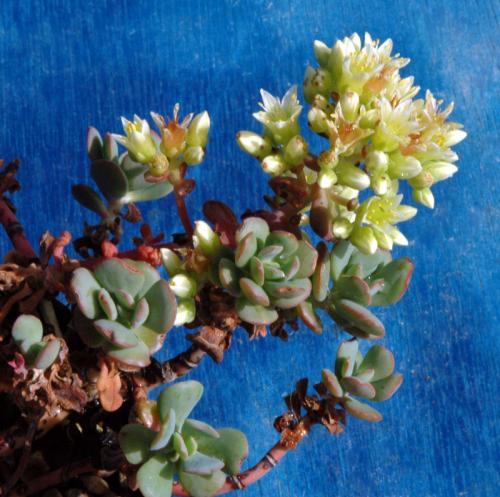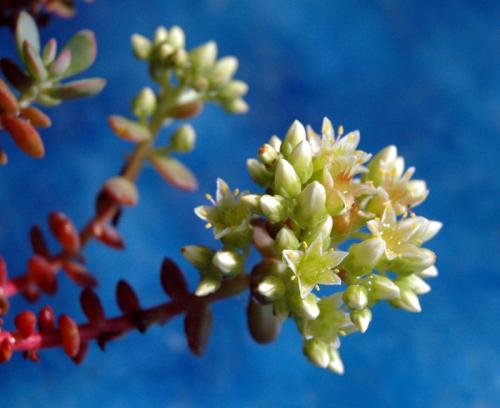OREGONENSE (S. Watson) M. Peck, 1941
Synonyms :
Cotyledon oregonensis S. Watson (1882)
Gormania watsonii Britton (1903) / Echeveria watsonii (Britton) Nelson & Macbride (1913) / Sedum watsonii (Britton) Tidestrom (1927)
Distribution : Western USA (Oregon, northern California: Cascade and Klamath Mts.) ; 1190 - 1590 m.
Description (by 't Hart & Bleij in IHSP, 2003) :
Glabrous perennial herbs with thick much-branched rootstock with fleshy rosettes.
Leaves alternate, obovate or oblanceolate, emarginate to retuse, sessile to sometimes subsessile, subterete, 10 - 36 x 5 - 16 mm, green and glaucous.
Inflorescences : Flowering branches erect, 6 - 28 cm, inflorescences panicles, bracts leaf-like.
FIowers 5-merous, pedicellate, sepals broadly sessile, basally connate, ovate,
subacute, ± 3,5 x 0,5 mm, greenish, erect, appressed to the corolla tube, persistent, petals basally connate, elliptic-oblong or oblanceolate-oblong, with erose margins, cucullate, whitish, erect at the base and divergent apically, persistent through fruit time, filaments pale yellow, anthers yellow.
Cytology: 2n = 90.
Ray Stephenson (Sedum, Cultivated Stonecrops, 1994, pp 206 - 207) :
Sedum oregonense is common in cultivation and sold under a plethora of names including S. obtusatum, "S. rubroglaucum," and "S. watsonii." It has fibrous roots and spreads quite rapidly to form loose, glaucous rosettes of succulent, emarginate leaves that rise from thick, straggling, horizontal stems, and are often clothed with dead leaves. Inflorescences carry creamy flowers with upright petals that often start life green-white, especially dorsally, and fade light orange. Vegetatively S. oregonense is very like S. laxum, but it is much more likely to be encountered than is the latter.
Habitat : Not a particularly widespread species from the Cascade Mountains (Mount Hood to Crater Lake, Oregon), and probably Klamath Mountains, this stonecrop prefers rocky, gravel slopes in sunny areas of the forest zone where there is little competition from other plants. Its altitudinal range is from over 1000 m (3000 ft) to under 2500 m (8200 ft).
Main points of distinction : Emarginate leaves are a feature this stonecrop shares with Sedum laxum (Leaf shapes, fig 5l). Flowers of S. oregonense are never really pink though as they fade they can blush somewhat. Like S. laxum, leaves on offsets tend to be opposite-decussate. Sepals are very short and are noticeably fused at the base - a key feature to differentiate this species from other Sedum species. Petals are fused below, erect, then spreading a little. They also are somewhat hooded. The long yellow stamens have anthers that sometimes flush with a hint of salmon pink. Small carpels are erect. Differentiating white-flowered forms of S. laxum ssp. heckneri from S. oregonense, its close relative, is most difficult. If a plant grows fairly quickly and spreads quite rapidly, it is most likely S. oregonense. Leaves of S. laxum tend to be at least 4 mm (0,15 in) thick.
Variation : One form, often sold as Sedum watsonii, is a very bold form with particularly thick, horizontal stems.
Horticulture : This hardy species has much to offer. It looks good in a rock garden. Planted in a trough, it takes many years before it needs to be cut back. Plants are too slow for ground cover, but, after 10 years, a single plant will cover a square meter (over a square yard) with a dense, blue-green, succulent mat. Plants grow much faster than those of the Sedum laxum complex.
See also S. moranii.
See also A review of Sedum section Gormania (Crassulaceae) in western North America, in Phytotaxa 368 (1): 1-61, 2018.

